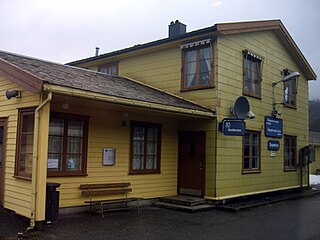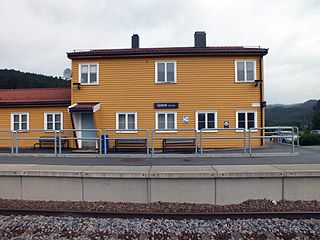
The Arendal Line is a 45-kilometer (28 mi) long railway line between Arendal and Simonstad in Norway. At Nelaug, 37 kilometers (23 mi) north of Arendal, the line intersects with the Sørland Line. The southern section is electrified and provides a feeder passenger service. The line originally ran 90 kilometers (56 mi) north from Arendal to Treungen and the lake Nisser, but the upper-most part has been removed. The line is owned by the Bane NOR and operated by Go-Ahead Norge using Class 69 trains.

The Grimstad Line was a 22-kilometer (14 mi) long railway line between Grimstad and Rise in Norway. The line was a branch of the Arendal Line, which is in turn a branch of the Sørland Line. Opened as the Grimstad–Froland Line on 14 September 1907, it was originally a private railway. The line was nationalized and taken over by the Norwegian State Railways in 1912. The railway was originally built with 1,067 mm narrow gauge, but was converted to standard gauge in 1936. Because of the cumbersome transfers, the line had few passenger and little freight. It was closed and demolished in 1961.

Nelaug Station is a railway station located at the village of Nelaug in Åmli municipality in Agder county, Norway. The station sits just north of the lake Nelaug. The station functions as a meeting station of the Sørlandsbanen and Arendalsbanen railway lines. The Arendalsbanen line is a branch line that runs from Nelaug to Arendal Station. Passengers from Oslo to Arendal must change trains at Nelaug. The station was opened on 10 November 1910, and in 1935, a new building was completed.

Arendal Station is the terminus railway station of the Arendal Line, located in Arendal, Norway. The station opened on 23 November 1908 and is served by the Go-Ahead Norge.

Eidanger Station is a disused railway station at Eidanger in Porsgrunn, Norway. Located at the intersection of the Bratsberg Line, Brevik Line and Vestfold Line, it is located 192.60 kilometers (119.68 mi) from Oslo. The station buildings were designed by Balthazar Lange.

Kragerø Station was a railway station located in Kragerø, Norway on the Kragerø Line.

Vennesla Station is a railway station located in the village of Vennesla in the municipality of Vennesla in Agder county, Norway. Located along the Sørlandet Line, the station is served by express trains to Oslo and Kristiansand. The trains are operated by Go-Ahead Norge.

Audnedal Station is a railway station of the Sørlandet Line situated just north of the village of Konsmo in Lyngdal municipality in Agder county, Norway. Located 419.34 kilometers (260.57 mi) from Oslo Central Station, the station is served by long-distance trains operated by Go-Ahead Norge. In addition to intercity services to Oslo and Stavanger, the eight daily trains in each direction serve as a commuter link to Kristiansand, located forty minutes away. The station features two platforms and a station building. Just west of the station is the Hægebostad Tunnel, one of the longest tunnels in Norway.

Snartemo Station is a railway station of the Sørlandet Line situated in the village of Snartemo in Hægebostad municipality in Agder county, Norway. Located 428.85 kilometers (266.48 mi) from Oslo Central Station, the station is situated on a 950-meter (3,120 ft) embankment between the Hægebostad Tunnel and the Kvineshei Tunnel.

Gyland Station is a railway station of the Sørlandet Line situated at Gyland in Flekkefjord, Norway. Located 453.53 kilometers (281.81 mi) from Oslo Central Station, it is served by long-distance trains operated by Go-Ahead Norge. In addition to intercity services to Oslo and Stavanger, the eight daily trains in each direction serve as a commuter link to Kristiansand, located 70 minutes away.

NSB Class 86 is a class of diesel-hydraulic multiple units built by Strømmens Værksted for the Norwegian State Railways (NSB). Thirty-eight motor cars and thirty-one trailers were built between 1937 and 1954, split between six subtypes designated a through f. Class 91 was a further delivery of ten units that had a more comfortable interior and designed for regional trains. The trains had good acceleration and a maximum speed of 100 kilometres per hour (62 mph), which made them suitable for most unelectrified lines in Norway. As most of the network gradually became electrified, the class became increasingly used on branch lines.
NSB Class 87 is a class of 25 diesel-hydraulic railcars built by Strømmens Værksted for the Norwegian State Railways. Seventeen a-series units were delivered in 1941 and equipped with 93-kilowatt (125 hp) Deutz prime mover. Eight b-series units were delivered in 1952 and equipped with 110-kilowatt (150 hp) Scania-Vabis prime movers. The trains weighed 15 and 15.5 tonnes and had a maximum speed of 75 and 80 kilometres per hour, respectively for the a and b-series. They were used on many branch lines until the 1960s, when the gradual electrification caused most lines instead to be served with Class 86. The a-series was scrapped in 1972 and 1973, while the b-series remained used between Ål and Hønefoss on the Bergen Line until 1975 and on the Flekkefjord Line until 1981.
Froland Station is a railway station in the village of Froland which lies along the river Nidelva in Froland municipality in Agder county, Norway. Located along the Arendalsbanen railway line, it is served by Go-Ahead Norge. The station was opened in 1908 as part of Arendal–Åmli Line.

Bråstad Station is a railway station at Bråstad in Arendal, Norway. Located on the Arendal Line it is served by Go-Ahead Norge. The station was opened as part of Arendal–Åmli Line on 23 November 1908 and originally consisted of a station building designed by Paul Armin Due, a guard house and a loading spur. The station was called Braastad until 1921 and remained staffed until 1928. Since the 1980s, the station has consisted of a shed and platform.

Storekvina station is a railway station on the Sørlandet Line situated at Storekvina in Kvinesdal, Norway. Located 446.36 kilometers (277.36 mi) from Oslo Central Station, it is served by long-distance trains operated by Go-Ahead Norge. In addition to intercity services to Oslo and Stavanger, the eight daily trains in each direction serve as a commuter link to Kristiansand, located an hour away.

Kristine Valdresdatter, officially known as NSB Cmb17a or Class 17, was a single railcar built by Strømmens Værksted in 1935. The train has a Buda gasoline prime mover with a mechanical transmission. This gave a power output of 90 kilowatts (120 hp) and a maximum speed of 100 kilometers per hour (62 mph). Originally delivered to the private Valdres Line. The Norwegian State Railways (NSB) took over the line in 1937. It was used on the Numedal Line from 1939 and the Grimstad Line from 1947. After a derailment in 1955, the railcar was retired and has been scrapped.
Johan Henrik Kintzell Frøstrup was a Norwegian judge and politician for the Conservative Party
Torbjørnsbu Station is a former railway station at Torbjørnsbu in Arendal, Norway. Located on the Arendal Line, it was operated by the Norwegian State Railways. The station was opened on 1 May 1911 and originally consisted of a station building and a loading spur. The station remained staffed until 1939 and was later closed.

Rossedalen Station is a former railway station at Rossedalen in Arendal, Norway. Located on the Arendal Line, it was operated by the Norwegian State Railways. The station was opened on 1 May 1911 and originally consisted of a small station building. The station has never been staffed and has never had a spur or passing loop.
Gulfoss Tunnel is a 701-meter (2,300 ft) railway tunnel situated in the municipality of Melhus in Trøndelag county, Norway. The tunnel runs beneath the village of Hovin, alongside the river Gaula past the Gulfossen waterfall. The tunnel carries a single, electrified track of the Dovrebanen railway line. The Trondhjem–Støren Line, which opened in 1864, crossed the river Gaula on a bridge to the opposite side of the river at the current site of the tunnel. This section of track was a challenge due to regular flooding. With the 1908 decision to build the Dovrebanen Line and gauge conversion, the Gulfossen section became one of two parts of the line to be reworked. Gulfoss Tunnel opened on 6 July 1918.














